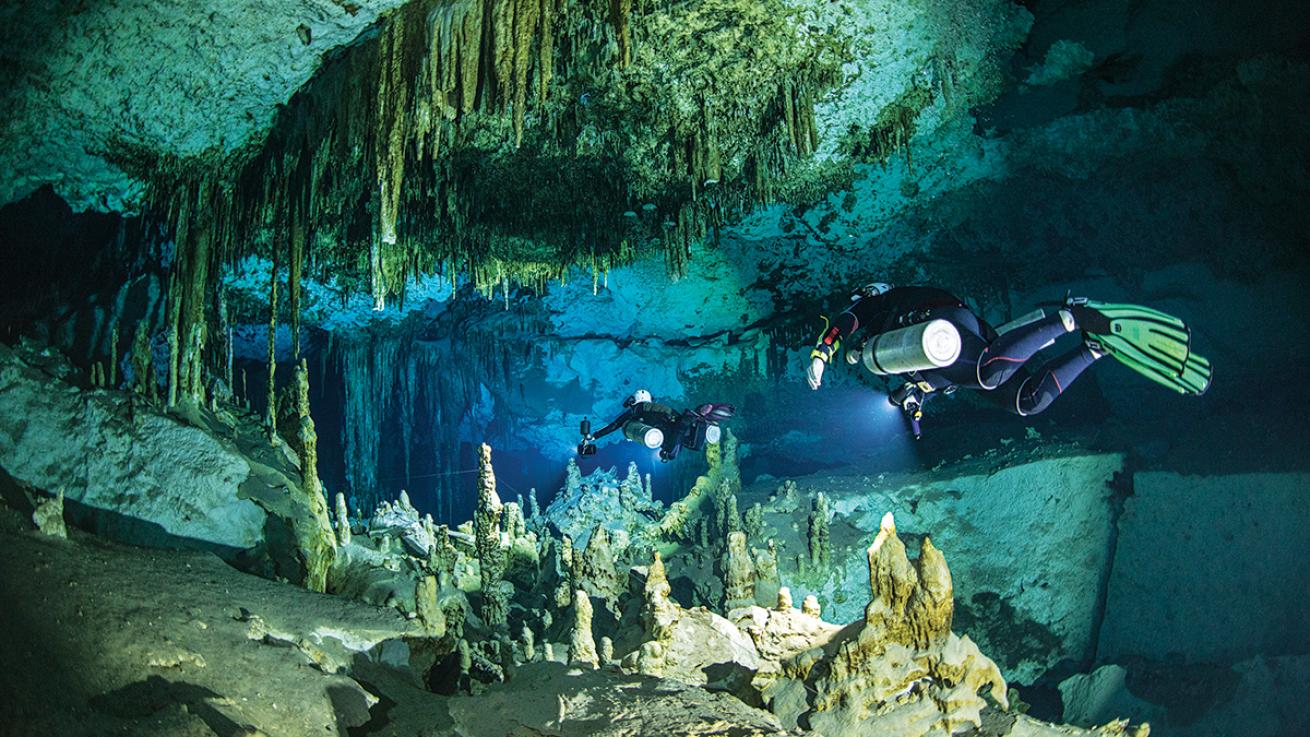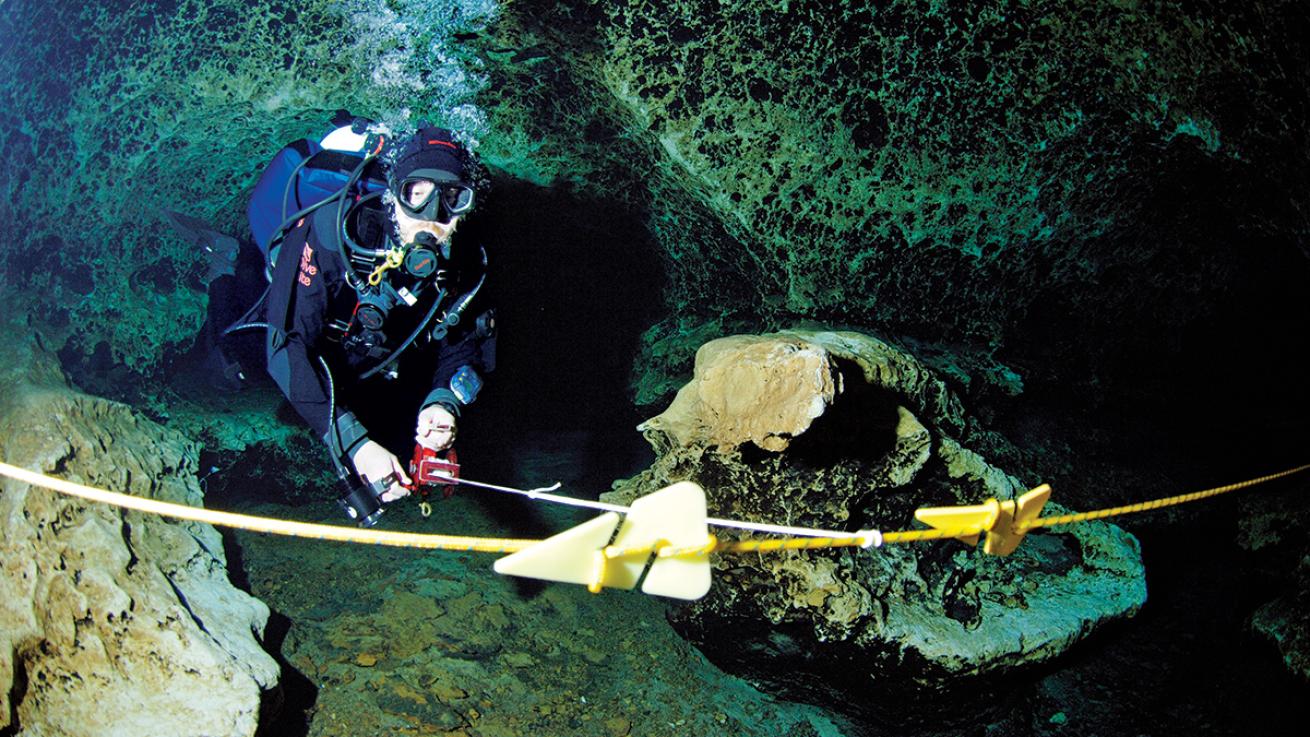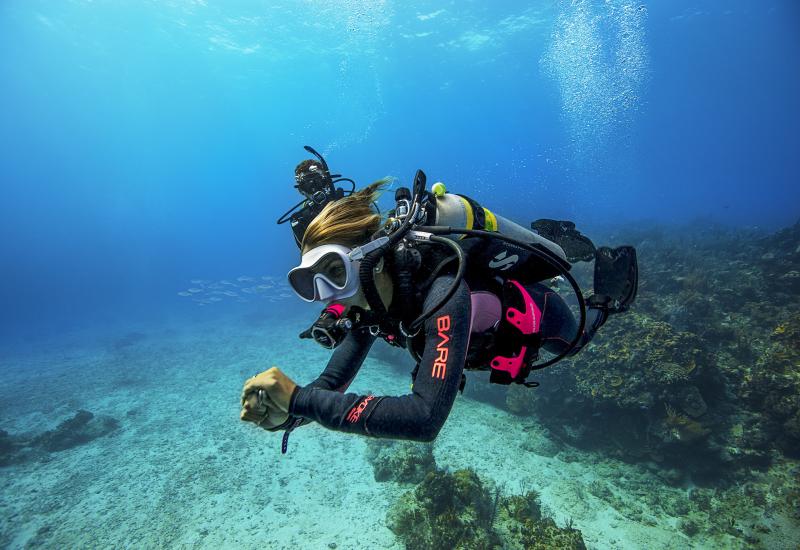Introduction to Cave Diving: What It Takes to Get Cave Certified

Jill HeinerthThe best prep for a cave diving class is to perfect your trim and buoyancy.
Most divers are drawn beneath the surface by a healthy sense of adventure fueled by a natural curiosity about what lies below. Cave diving is no different — just amplified. Rare and amazing underwater environments are hidden deep underground; the attraction of seeing what a mere handful of others experience has a powerful gravity.
“There’s something special about being in the cave,” says Jon Bernot, owner and primary instructor of Cave Country Dive Shop in High Springs, Florida. “It’s something very difficult to explain unless you’ve actually experienced it.”
The training director of the National Speleological Society’s Cave Diving Section develops hopeful subterranean explorers from around the world in the heart of north Florida cave country, where he not only broke the world record for distance dived in a cave — 27,000 feet (more than 5 miles) in the Falmouth System with his Karst Underwater Research partner, Charlie Roberson — he bought the property and now owns the cave system.
World's Best Destinations for Cave, Cavern and Grotto Diving
“A lot of cave divers start with a recreational cavern course or an introduction to the overhead program,” he says, courses created as a result of hundreds of cave fatalities in the 1970s among untrained or open water divers. “That introduction gives them an idea of the hazards they could expect in the overhead,” Bernot says, and the benefits.
That interest must be strong to sustain a student through rigorous training. Before signing up for a cave course, Bernot recommends that divers complete advanced open water training, including some technical diving with dual cylinders, and more than 100 documented dives in a variety of conditions.
How Does a Cave Course Work?
While the training agencies that certify cave divers — Technical Diving International, Global Underwater Explorers, International Association of Nitrox and Technical Divers, and others — offer different signature programs, there are fundamental similarities.
Typical overhead-environment training ranges from entry-level cavern diving and introduction to cave diving courses to full cave diving courses and specialty courses for closed-circuit rebreathers, diver-propulsion vehicles and other options. Most instructors, including Bernot, can complete certifications through multiple agencies and will work with students to determine the courses that best suit the individual’s needs and goals. The investment in such training ranges from $1,500 to $2,000 per level.
“Most people do the course in two sections — the basic cave, or cave one, course, which is usually five or six days, then the full cave, or cave two, program, which takes another five or six days,” Bernot says. “By the end, students will have done anywhere from 16 to 24 dives in an overhead training environment.”
Equipment for Cave Diving
Equipment is critical in cave training. Most gear used in recreational diving doesn’t transfer to cave diving. The need for more-rugged exposure protection (drysuit), more-robust life support, cave-specific tools including line reels and markers, and redundant systems from regulators to lights requires a substantial investment. Students should expect to spend $3,000 to $4,000 on the required gear, according to Bernot.
Where to Get Certified for Cave Diving
Another important consideration is location. Overhead environments appropriate for training are uncommon; because most programs require training dives in a minimum of three to five different caves, selecting a suitable destination is key. Bernot counts north Florida and Mexico’s Yucatan Peninsula among his preferred locations. “The top four sites in north Florida that I recommend are Peacock Springs, Ginnie Springs, Little River Springs and Jackson Blue,” he says. “If I train people in Mexico, Grand Cenote, Nohoch Nah Chich, Ponderosa and Dos Ojos are four of the best sites.”
Because cave diving is a team sport, undertaking a cave course with a friend who has similar experience and ambitions is a strategy Bernot recommends. “Students get more out of cave training if they can find a teammate,” he says. “We do train individual divers, but most instructors will find a stand-in, typically an instructor candidate or an experienced cave diver, to act as a team member if it is a single-person class, which is standard across the training agencies.”

Jill HeinerthLearning to run lines is a key skill taught in cavern and cave courses.
What Will You Learn in a Cave Diving Course?
The training required to dive safely in overhead environments is detail-oriented, heavy on protocol and seriously consequential. But when broken down into fundamentals, it might not seem so daunting an enterprise.
“It’s not just a sightseeing tour,” Bernot says. “You’ve got to be able to go into the cave, navigate, maintain absolute buoyancy control, and perform a diverse set of challenging tasks. Mastering buoyancy, situational awareness and task loading, in that order, is crucial, and sometimes we don’t start cave diving until we’ve spent a day or two focusing on [those tasks] because there’s no point in going to the next level if the student hasn’t mastered these fundamental skills.”
Underwater Photo Tips for Shooting in Caverns
To simplify the process, Bernot focuses on what he calls the “five tenets to accident analysis in the overhead.” By identifying what can most typically go wrong and focusing on prevention, divers can increase their safety.
Training: “Not being properly trained or exceeding your training is probably the number-one cause of all cave accidents.”
Guide Lines: “A continuous guide line will be maintained from the exit all the way to the point of farthest penetration. When somebody stirs up a zero-visibility silt-out, that guide line is your only trail of breadcrumbs to the exit.”
Gas Management: “We use, as a maximum, the rule of thirds — not just to ensure we have enough gas to exit or share, but also to make sure we have a reserve to problem-solve if something else happens. There is no bolting to the surface in the overhead.”
Light: “We carry a minimum of three lights in the overhead so if we have a light failure, it doesn’t create an emergency but instead simply an inconvenience that causes us to cancel the dive.”
Depth: There’s less margin for error at great depths. “And nitrogen narcosis comes into play more frequently, which is historically one of the biggest hazards for trained cave divers.”
The Hack: Diving with Blinders On
For cave divers, the possibility of the lights going out (literally) is ever-present, whether by silt-out or torch malfunction. To prepare for such a deadly emergency, cave training typically involves a blindfold at some point. Under controlled, supervised circumstances, this is an exercise that practically any diver can practice. Performing fundamental tasks such as sharing air or buddy ascents, removing and donning equipment, or switching cylinders without the benefit of sight can improve mental focus and accelerate critical muscle memory, which can make any underwater task more successful and every dive safer.










